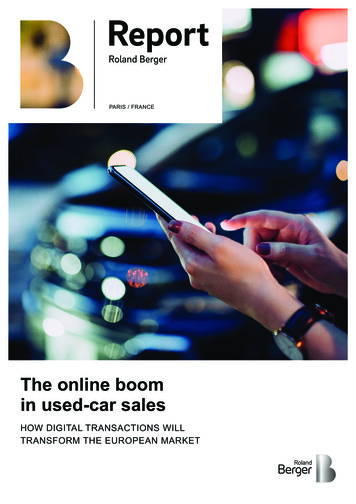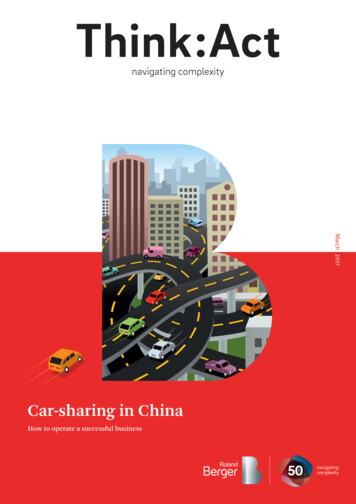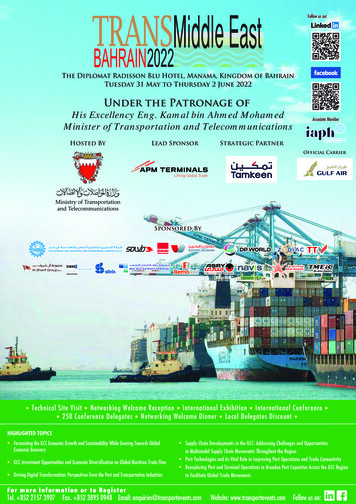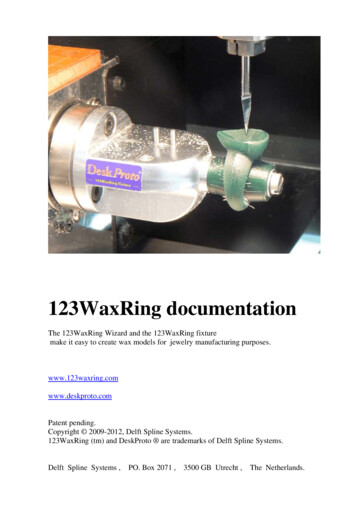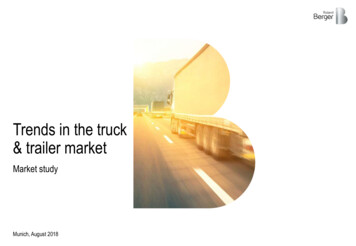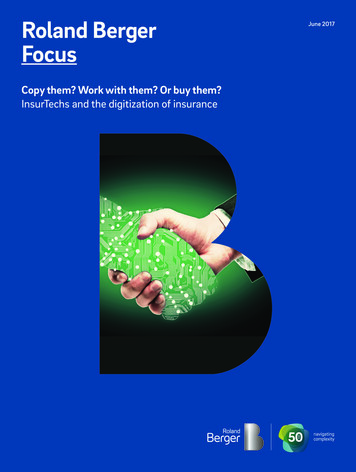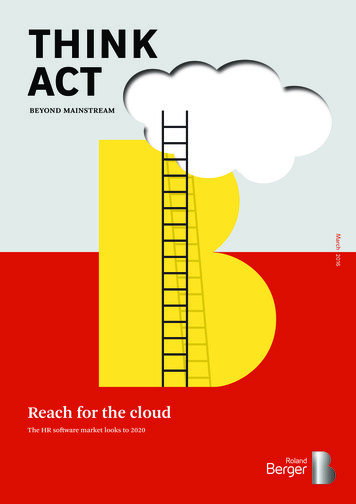
Transcription
THINKACTBEYOND MAINSTREAMMarch 20162015MasteringthecloudReachfor theTheHR software market looks to 2020 JourneyTransformationA comprehensive guide to reinventing companies
2 THINK ACTReach for the cloud3THE BIGMAJO4R TRENDSARE SHAPINGTHE MARKETP.4100interviews conducted with decision makersand experts from HR software vendors.page 3EURO 1.7 BNis the expected volume of the German HR softwaremarket by 2020.page 486%till 2020 is the predicted growth of thestrongest driver in the market: the transitionto cloud based solutions.page 6
THINK ACT 3Reach for the cloudWhat is going on in theworld of HR software?Do you understand themarket situation wellenough to make the rightsoftware purchases?Roland Berger conducted over 100 interviews with decision makers and experts from HR software vendorsand customers focusing on the four key features of theHR software market: Market size and growth, competitive environment, customer behavior and markettrends. Add in a raft of primary and additional secondary research and the result is a comprehensive, quantitative market model.This report will enable vendors to sharpen theirview of the market and adjust their business model accordingly, for instance by increasing their focus onsmaller customers and specific verticals. In case youare a customer, this report will dramatically improveyour understanding of the current market situationand thus enable you to make the right purchase decisions for your HR software."Cloud will comeno matter what, thequestion is only howlong it will take themajority of companies to adopt it"GLOBAL TRANSPORTATION PLAYER,VP GLOBAL HR TRANSFORMATION
4 THINK ACTReach for the cloudSeven product segmentsmake up a German HRsoftware market worthEUR 1.3 bn today.The German HR software market reached EUR 1.3 bnin 2015 and will hit EUR 1.7 bn by 2020. Althoughgrowth is being achieved in all seven product segments, it is stronger in the strategic HR segments (recruiting, performance & talent management, learning& development and employee collaboration & engagement) than in the administrative HR segments (employee data administration, compensation & benefits,workforce management). Accompanying strong growthfrom small and medium-sized enterprises (SMEs),cloud based solutions make a significant contributionto relative growth, despite being inhibited by variousfactors including data security and privacy aspects.The competitive environment has proven to be ratherconsolidated in the administrative HR segments, whilethe strategic HR segments remain at a fairly low consolidation level. For the latter in particular, this is driven by many micro players developing their niches besides large players with global reach such as theindustry primus SAP/SuccessFactors. To access dispersed markets such as the SME segment, system integrators provide an alternative indirect route to market.Regardless of the segment, customers are focused onproduct quality (in this case a mix of usability, flexibility and integration) and consider price only after theirquality requirements have been fulfilled.FOUR MAJOR TRENDS SHAPING THE MARKETThe market described above is shaped by four majortrends. Increasing HR software budgets provide futurepotential for investments and innovation. The switchfrom on-premise to cloud based solutions is evidentlytaking off and substantially driving growth in this area.Simultaneously, this raises concerns about data security & privacy, which must be taken into consideration –especially in German companies with strong workscouncil co-determination rights. These concerns areintensified by German companies having an emotionalpreference for cloud based data to be hosted in Germany, even though the entire European Union could beconsidered from a regulatory perspective.For HR software customers, this implies the needto consciously assess the state of their HR softwarelandscape. New technologies and offerings in a competitive market environment may provide less costlysolutions to existing or as-yet unsolved problems. ForHR software vendors, it becomes crucial to respondstrategically and sustain their competitive advantages, e.g. via M&A activities. All things considered, bothsides need to actively prepare to reach for the cloud.
THINK ACT 5Reach for the cloudMarket sizing andgrowth: AdministrativeHR segments are largerin size but lower ingrowth than strategicHR segments.The German HR software market reached a volume ofabout EUR 1.3 bn in 2015 and is expected to grow annually by approximately 5% to total some EUR 1.7 bnby 2020. AThe market can be broken down into three administrative HR product segments, employee data administration (EDA), compensation & benefits (includingpayroll), and workforce management (WFM). Furthermore, there are four strategic HR product segments,namely recruiting, performance & talent management,learning & development, and employee collaboration &engagement. BThe administrative HR segments have a tendencyto show lower growth than the strategic segmentswhile currently still accounting for a larger share of themarket. The slower growth is primarily attributable tocustomers being reluctant to switch HR software vendors, thus creating product life cycles of 7-10 years.This immobility is driven by the high customizationlevel that is required to handle the present complexity,the interdependencies with other systems, the highsensitivity of processed data and the importance forthe going concern of the company.IMPORTANT GROWTH DRIVERSThe most common growth drivers mentioned by ourinterviewees include the gradual but ever more certaintransition to cloud based software, the strong growthamong small and medium-sized enterprises (SMEs), aswell as several industry verticals experiencing elevatedgrowth rates, including retail.The strongest growth driver in the market is thetransition from on-premise (licensed) software tocloud based solutions (or Software as a Service – SaaS).With an expected per annum growth rate of approximately 13% in 2014-2020, the segment will be wortharound EUR 600 m in 2020. In contrast, the on-premisesegment is expected to grow only at about 2% annuallyin the same time frame, reaching a total volume ofsome EUR 1.1 bn. C
6 THINK ACTReach for the cloudABABOVE AVERAGE GROWTH RATE TO BEEXPECTEDGerman HCM software market 2014-20 [EUR bn]SEVEN SEGMENTS MAKE UP THE HR MARKETGerman HCM software market by product segment,2015 [%]4%Employee collaboration& engagement1.71.31.224%Employee dataadministration11%Performance &talent managementCAGR 5%13%Learning 420159%Payroll, compensation& benefits2020Administrative segmentsStrategic segmentsCDA MAJOR GROWTH DRIVER IS CLOUD BASEDHR SOFTWAREGerman HCM software market by deployment type,2014-20 [EUR bn]DEMAND FOR NEW SOFTWARE IS ESPECIALLYSTRONG IN THE GERMAN "MITTELSTAND"German HCM software market by customer segment,2014-20 [EUR bn]1.70.31.21.31.00.92014Cloud0.32015 86% 11%0.41.11.220142020SMESource: Roland Berger0.41.30.90.8On-premiseHCM Human Capital Management1.70.6Large20150.7 55% 16%1.02020
THINK ACT 7Reach for the cloudCurrently significantly smaller, the share of cloudbased solutions is driven first by the unclear legislativesituation regarding data security and privacy, and second by the large market share occupied by administrative HR software, which has an inherently lower cloudadoption rate.Lower upfront investment in IT infrastructure andmore innovative technology that enables products including self-service and mobile features are furtheringthe growth of the cloud segment. The rather standardized cloud solutions, customizable only via parametrization, represent a good fit for SME companies withlower complexity and less need for customization.However, there are also inhibiting factors, such as theabolition of the "safe harbor" agreement. While thismay change the way in which cloud based solutions arerealized, it does not jeopardize the momentum of thetrend.A strong source of growth is the German SME customer segment, the fabled "Mittelstand", encompassing companies with fewer than 1,000 employees. Thissegment is expected to grow at about 9% per annum inthe period 2014-2020, reaching a volume of approximately EUR 710 m in 2020. This stands in contrast tothe large enterprise segment (LE), expected to grow bysome 3% yearly to around EUR 990 m in 2020.Even though the majority of employees in Germanywork in the SME segment, its HR software market issmaller due to the lower penetration level overall andless suitable products in some areas (historic dominance of complex and highly customized on-premisesolutions).SMEs are growing faster now because they canleverage shorter and simpler decision processes as wellas less complex company structures. They have a lowerneed for (global) IT harmonization and can thus undertake smaller projects in distinct parts of their HRsoftware landscape. Enabled by the cloud trend, theytend to do so by choosing best-of-breed providers thatensure a balanced range of standardized and cloudbased software, which simultaneously provides industry and company size specific functionality. DIndustry verticals exhibit growth rates ranging between about 4-6% annually in the period 2014-2020.In manufacturing, for example, the trend towardgreater specialization and Industry 4.0 creates theneed for industry specific solutions to cover uniquerequirements.DEEP DIVE ON PAYROLLTo illustrate the effects of the growth drivers discussedabove and how they manifest themselves individuallyin each market segment, we looked more closely at thepayroll segment.The payroll segment in question excludes the business process outsourcing (BPO) share of the market,and is expected to grow by about 4% per annum in2014-2020 to reach a volume of around EUR 148 m in2020.The cloud influence described above holds true forpayroll, its cloud based software share being fairlysmall (approximately 7% in 2015) but growing morestrongly than the on-premise segment (approximately7% vs. 4% per annum in 2014-2020). The above-mentioned factors limiting cloud adoption can be appliedto payroll as well. Complexity plays an especially important role in payroll: Dozens of updates on federallegislation concerning payroll calculations, a variety ofcollective and union agreements and many differentemployee groups contribute to system complexity.This complexity can only be met with a high level ofcustomization, one aspect still better catered for byon-premise solutions and hence substantially limitingthe influence of cloud based solutions' growth.In terms of customer size, the SME segment is expected to grow by about 5% per annum in 2014-2020(vs. the LE segment with approximately 3% annualgrowth in the same time frame). Growth can be realized by penetration gains from pen & paper as well aspayroll outsourcing customers. SMEs seem to preferbest-of-breed solutions providing tailored systemswith a higher standardization level, in keeping with thecloud advantages mentioned previously. The increasing scale of cloud adoption also drives a shift toward alarger share of the market realized with service andmaintenance contracts.
8 THINK ACTReach for the cloudCompetitive environment: Market shaped bya few large players and avariety of micro players.The competitive environment in the administrative HRsegments is perceived as being highly consolidatedwith a few established players and a variety of verysmall micro players.Digitization took a hold in these administrative HRsegments first, resulting in greater maturity than strategic HR segments, with industry leaders able to claimdominant market positions. The textbook example,SAP, has a strong presence in the LE segment and provides an all-in-one solution. It services the highestcomplexity levels on a global basis and is highly customizable. Despite the resulting good fit to companies'individual requirements, customization simultaneously creates a lock-in effect: Any switch of providers wouldrender substantial previous spending wasted.The competitive environment does, however, haveto be analyzed on a segment by segment basis, sincefew players excel in all areas. The payroll segment, forexample, has one of the highest anticipated consolidation rates; as much as 65-90% of the market is catered for by the top 10 players. The early establishment of the market, particularly long productreplacement cycles, high complexity driven by the local variations in the nature of the subject, and frequent updates favor the establishment of large players. Simultaneously, this environment opens upniches in industry vertical sub-segments, which canbe covered by small micro players providing schedul-ing solutions in the workforce management segmentfor hospitals as part of the healthcare sector. EThe perspective on strategic HR segments turns outto be inverted – consolidation seems to be rather low.Here, medium-sized and small players compete in themarket with a strong technology focus, offering products with self-service and mobile features. The shorterproduct life cycle in combination with lower upfrontinvestments, shorter contractual obligations, morestandardized interfaces and data models reduces riskand allows for less expensive provider switches. Customers of all sizes have to deal with the consequencesof demographic change and the lack of qualified labor,which serve to put more pressure on related HR software segments such as talent & performance management and recruiting. ERegardless of whether the subject in question is theadministrative or the strategic segment, system integrators are essential market participants in the competitive arena. They provide an indirect alternative tothe conventional direct sales channel. For HR softwareproviders, they can thus offer an attractive way to reachthe customer, which is a very interesting propositionespecially in a small and fragmented customer segment. From a customer perspective, system integratorsprovide a neutral counterpart offering specialized expertise and able to help navigate through the market.
THINK ACT 9Reach for the cloudETOP MARKET PLAYERS ANDCONSOLIDATION PER SEGMENTAdministrative HR segmentTop playersEMPLOYEE SAPATOSSKabaIsgusConsolidationlevelStrategic HR segmentTop playersRECRUITINGPERFORMANCE& TALENTMANAGEMENTLEARNING &DEVELOPMENTEMPLOYEECOLLABORATION& ource: Roland Berger assessment based on more than 100 interviews with decision makers and experts from HR software vendors and customers betweenNovember and December 2015 – enriched with a raft of primary and additional secondary research and background information.
10 THINK ACTReach for the cloudCustomer behavior:Product quality, servicequality, price and easeof implementation.Customers in the HR software market behave in a waythat appears to be consistent across all industries. Thiscan ultimately be condensed into key purchasing criteria that guide customers' buying decisions.First, customers determine what constitutes product quality for them, what level is required to servetheir purpose, before seeking out vendors able tomeet these requirements. For most customers, product quality is a mix of usability ("Can my employeesuse it efficiently and with little or no training?"), flexibility ("Can it cover the level of complexity we need?")and integration ("Can we integrate it seamlessly viainterfaces?").As soon as the product quality criterion is fulfilled, customers proceed to the next one in line,namely service & maintenance quality ("Can I easilyget in touch and how well and how fast do they resolve issues?").Assuming the first two criteria are sufficiently wellmet, the price factor comes into play. Despite beingranked third, price is of the utmost importance andplays a pivotal role in strategic HR segments wheremany vendors compete against one another. Conversely, price becomes obsolete as a criterion as soon ascompanies are "locked in" by highly customizedon-premise systems that simply cannot be switched, aphenomenon that occurs more often in the administrative HR segment.The ease of initial implementation presents a final hygiene factor ("How long will implementation take,what manpower is needed on my side and what will itcost me?"). FApart from these key purchasing criteria, it is common to establish customer loyalty via a trust based relationship. For customers to decide in favor of a HRsoftware vendor, especially in the administrative segment, a trust based relationship is essential. Its intensity increases over the long product lifetime and consequently presents itself as an advantage if a vendorswitch should be on the cards.Such switches usually take place in specific situations, e.g. when a company has outgrown their existingsystems in terms of employee numbers, when the business model has changed and introduced new requirements or when the old and new systems are no longerin harmony with one another.The decision process customers run through isnormally driven by HR, which defines its specific needstogether with IT. Depending on the software segmentconcerned, adjacent functions may be included, e.g.the finance function in the case of payroll. As soon asa tender comes into question, the procurement officecan be brought into play. The works council and dataprotection officer need to be involved throughout theprocess as well. Final decisions are usually made by anexecutive committee.
THINK ACT 11Reach for the cloudFKEY PURCHASING CRITERIATHAT GUIDE CUSTOMERS' BUYINGDECISIONS.In the German HR software marketKEY PURCHASINGCRITERIAPERCEIVED CUSTOMERIMPORTANCELowHighFlexibility viacustomization andcovered complexityLowHighIntegration possibilitiesand connectivity/interfacesLowHighService & maintenancequalityLowHighPrice attractiveness tocustomersLowHighEase of implementation(e.g. time, investment)LowHighPRODUCT QUALITYUsability for operativeend users
12 THINK ACTReach for the cloudMarket trends:Increasing HR softwarebudgets are investedin cloud solutions in theface of data securityconcerns.Throughout our interview series, HR software customers and vendors indicated a variety of underlying drivers in the market. We condensed four major trendsthat were consistently of relevance, and which seem tohave an extraordinary influence on the market environment.disposal, e.g. in renewing old systems or extending thescope of current applications. Vendors of HR softwarewill need to minimize customers' reservations aboutmaking the investment, e.g. by providing a track recordof successful implementations with seamless and fastimplementation.HR SOFTWARE BUDGETSCLOUD ADOPTIONThe overall software budgets of German companies areexpected to increase going forward, driven by trendssuch as digitization. Correspondingly, German HRsoftware budgets are expected to remain stable or increase. Major motivators seem to be the aging softwarelandscape as well as investments in the talent pipeline.HR software budgets are primarily funded by HR,though infrastructure relevant budgets from IT andcorporate level may also come into play.For the HR software market this substantiates theexpected growth. Customers of HR software will haveto ask themselves where to invest the resources at theirGenerally, usage of cloud computing is increasing immensely across verticals and customer segments inGermany, even though the overall level still remainsbelow that of pioneers such as the UK and the US. Thesame holds true for the HR software market: Cloudadoption is increasing strongly, albeit with limited absolute effect as yet due to the small basis upon whichthe trend is building.As mentioned above, growth is driven by the various advantages of cloud based solutions: Lower upfront investments, lower switching costs, higher standardization with improved connectivity via interfaces/
THINK ACT 13Reach for the cloudstandardized data models, and new technological features. Simultaneously, factors like the sensitive natureof HR data combined with data security and privacyissues and the limited customization via parametrization inhibit the trend's effect.For HR software customers, this implies the needfor sound decision making between on-premise andcloud based solutions in all relevant segments. Forvendors of HR software, this, in turn, creates the necessity to provide cloud based HR software solutions,with or without on-premise solutions – the latter option seems feasible in the strategic HR segment, whilea dual offering may suit the administrative segmentbetter.DATA PROTECTIONData protection is a highly topical issue for HR in Germany and needs to be addressed appropriately whendiscussing HR software. Beyond HR itself, the Germansituation is unique owing to two institutions installedby the BDSG ("Bundesdatenschutzgesetz" or FederalData Protection Act) and BetrVG ("Betriebsverfassungsgesetz" or Works Constitution Act):1. Works council: Employee representation with themandate to compensate for the uneven distribution ofpower between employer and employee. Every Germancompany with more than five employees can have aworks council and it is likely to have co-determinationrights regarding the introduction or change of any HRsoftware solutions.2. Data protection officer: An internal or external officer whose purpose is to ensure adherence to the BDSGand other data protection legislation. The officer has tocontrol and work toward the successful implementation of the BDSG and other related legislation; however, the data protection officer has information and participation rights only.What this implies for HR software customers is theneed for timely involvement of the relevant parties; asfar as the works council is concerned, it involves clearlyidentifying motives and goals to help establish compromises. HR software vendors can help here, for instance by ensuring full software functionality evenwithout certain critical features, providing information tailored to the works council's demands, etc.DATA HOSTINGOne aspect closely related to data protection concerns the data hosting location. In light of the generaldata security situation, which is fraught with distrustand legal uncertainty, German companies have astrong, rather emotional tendency to prefer data hosting in Germany. This is the case even though from aregulatory perspective, data hosting in any country ofthe European Union would be feasible.Certainly in the wake of the abolition of the "safeharbor" agreement, data hosting outside of the European Union is perceived as highly undesirable anddoes not represent an option for most German companies. Regulation of data handling via standard EUcontractual clauses or processor binding corporaterules cannot bridge this security gap and is generallyperceived as insufficient."Data trustee" models, following the Microsoftand Deutsche Telekom example, may become a newtrend: Here, companies originating from outside ofGermany use a Germany based data hosting providerand voluntarily renounce all access to their own data.This prevents any third party access that could possibly be enforced by the foreign company's nationalgovernment.From the customer perspective, EU hosting locations other than Germany should also be considered.From a vendor perspective, hosting in Germany willalways be perceived as an advantage against competitors with non-German hosting.
14 THINK ACTReach for the cloudConclusion andrecommendation:Customers and vendorsneed to prepare todevelop into the cloud.If you are a HR software vendor, you might want tofocus on developing a unique value proposition byconcentrating on certain customer segments and specific verticals.The growing market will increase competitionamong vendors who will try to differentiate on qualityand technological levels. This will trigger innovationand may bring new software forward, solving as-yetunaddressed problems or improving existing solutions. Established HR software vendors will be challenged by new entrants with new cloud based innovative solutions. Defining clear response strategies toensure a sustainable market position will be key. Thepriority has to be on ensuring a sustainable competitive advantage that creates a unique customer valueproposition. Vendors can either grow organically orpursue M&A activities targeting one of the evolvingsmall players.Cloud providers will need to address data protection issues including the hosting location of cloudbased data. This involves aspects such as the early andwell prepared involvement of works councils, as well assustainable data hosting solutions, possibly using thenew "data trustee" model.If you are a customer you might want to review yourexisting HR software landscape, looking for new solutions that add value and bring cost savings potential.New features and capabilities, which were thus farout of reach or financially unattractive will provideyour buyers with software solutions that will help youbecome more effective and cost efficient. Cloud basedsolutions are becoming more and more attractive forSMEs due to lower complexity and higher value fromstandardized products. Cloud solutions provide customers with the added flexibility that comes from astandardized process and data model. This enablesyou to switch providers more easily, thereby puttingyou as customers in a stronger buying position.The cloud is out there. Reach for it.
THINK ACT 15Reach for the cloudABOUT USRoland Berger, founded in 1967, is the only leading globalconsultancy of German heritage and European origin.With 2,400 employees working from 36 countries, we havesuccessful operations in all major international markets. Our50 offices are located in the key global business hubs. Theconsultancy is an independent partnership owned exclusivelyby 220 Partners.FURTHER READINGLinks & LikesORDER AND DOWNLOADwww.rolandberger.comSTAY TUNEDwww.twitter.com/RolandBergerLINKS AND ntsTHINK:ACT SPECIAL:CLOUD ECONOMYThe path to new business modelsTHINK:ACT CONTENTIT outsourcing involves morethan ITSocial networks are simply themost obvious manifestation of atrend in which ever-larger partsof our personal lives are shiftingonline. Business networking is alsogradually making the transition tovirtual reality. This transformationhas a huge amount of businesspotential. We call it the cloudeconomy: an environment in whichcompanies can use new technologyto harvest huge quantities of onlineuser data and integrate it into theirbusiness models.IT outsourcing often feels like alottery where you are always drawingthe wrong number. While it should bea guaranteed win, more often thannot you turn out to be the loser. Thatis why many managers whooutsource IT operations feeldeceived. Often they are right. Worsestill, to a large extent they only havethemselves to blame. But there is abetter way to make sure that firmscan get what they want.A detailed insight intocurrent thinking atRoland Berger is availablevia our new microsite atnew.rolandberger.com
PublisherROLAND BERGER GMBHSederanger 180538 MunichGermany 49 89 9230-0www.rolandberger.comWE WELCOME YOUR QUESTIONS, COMMENTSAND SUGGESTIONSJÖRG SEUFERTPartnerMunich 49 89 9230-8666joerg.seufert@rolandberger.comEditorDR. KATHERINE NÖLLINGkatherine.noelling@rolandberger.comThis publication has been prepared for general guidance only. The reader should not act according to anyinformation provided in this publication without receiving specific professional advice. Roland Berger GmbHshall not be liable for any damages resulting from any use of the information contained in the publication. 2016 ROLAND BERGER GMBH. ALL RIGHTS RESERVED.TA 16 007LARS SUHRENConsultantHamburg 49 40 37631-4306lars.suhren@rolandberger.com
cision makers and experts from HR software vendors and customers focusing on the four key features of the HR software market: Market size and growth, compet-itive environment, customer behavior and market trends. Add in a raft of primary and additional second-ary research and the result is a comprehensive, quanti-tative market model.
